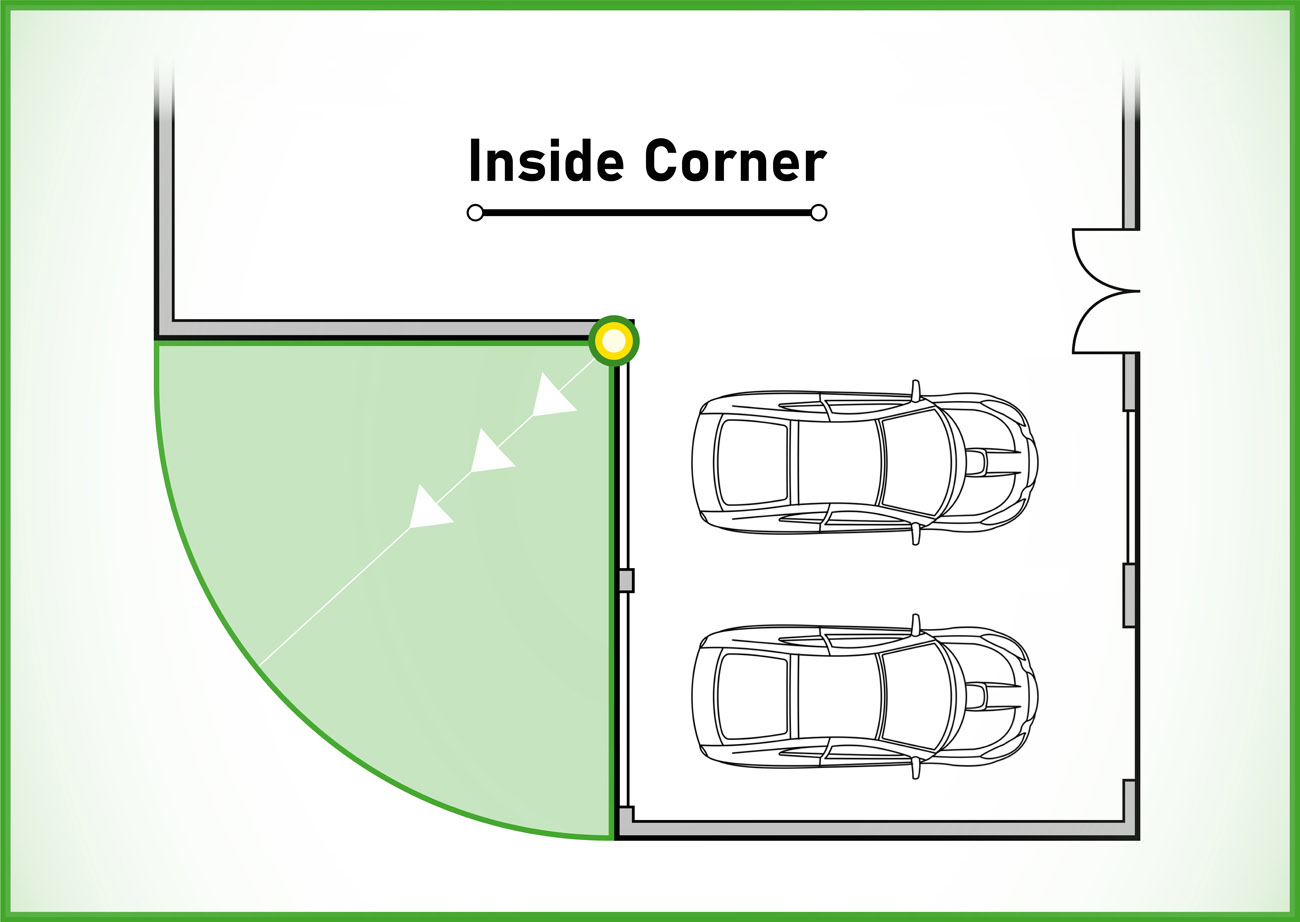7 - Best Camera Locations
So where should you locate your security cameras?
Below are a few of the most common viewing patterns. Each has benefits and possibly some draw backs. Your application will dictate which design is most effective.
Mid Wall Pattern
A Mid Wall Pattern means mounting a camera in the middle of a wall horizontally and adjusting its view perpendicular to the wall. This location can be useful for certain applications but is seldom used by security professionals, simply because it results in blind spots on each side of the camera. A 3.6mm lens provides the widest viewing angle without distorting the image. There are 180 degree cameras on the market but they distort the video so badly that the video is useless at distance. We do not recommend using any lens wider than a 2.8mm, which provides a viewing angle of 110 degrees. Because of the extremely wide view, we cannot expect great clarity beyond 60 feet. A 2.8mm lens should be used for up close applications - such as a porch or any location where you desire a very wide angle of view up close but do not require great detail at distance (beyond 60ft).

Back-to-Back Pattern
A Back-to-Back Pattern means placing two cameras back to back mid wall. This design eliminates the blind spots that can occur when using the mid wall method. Since the 3.6mm lens opens up at 90 degrees, it is the natural choice for this application. This is the best solution for a 180 degree field of view (two 90 degree cameras back to back).

Secret Service Pattern
The Secret Service Patterns uses two cameras that are installed on the same wall, separated by 15-20 feet and aimed towards each other. Essentially, the cameras are watching each other’s back so that neither camera can be disabled without the perpetrator being seen. This design works well with both fixed view and zoom lens cameras.

Corner-to-Corner
This design is the most common and provides several benefits. It makes the most of each camera's viewing capability and covers 100% of the perimeter. When the cameras are placed as the diagram below indicates, all blind spots are eliminated, and the cameras cannot be vandalized without the perpetrator being recorded by another camera.

Inside Corner
The Inside Corner pattern is simple and very effective. Because a 3.6mm lens provides a 90 degree field of view, it is perfect for an inside corner. When using this method, the camera cannot be vandalized, and the corner is covered from wall to wall.

Where on the structure should the camera be located?
Most cameras are installed either on or under a building's soffit. Cameras will have the same performance whether they are mounted vertically to a wall or horizontally on a soffit. However, when installed under a soffit, cameras are usually protected from harsh weather and the sun's UV rays - both of which reduce the lifetime of the camera. Mounting on or near a building's soffit is preferred. Below you will find a graphic that indicates the soffit of the house, as well as the fascia, both of which may be good choices for camera placement.

Cameras are usually mounted to the structure they are protecting. We have had clients attempt to mount cameras on trees or poles with the camera looking back at the building. This increases the installation difficulty and does not provide a security benefit. Often, such remote camera locations can actually reduce the overall security of the system as the cameras can be approached from their blind spots and disabled.
The design of the building or home will dictate where the cameras can be located. When selecting a location consider any area that has attic above or unfinished basement below. Both provide the ability to run wire. Keep in mind there are usually two possible camera locations for each camera. Select the location most likely to benefit the installation.
What height should a camera be mounted?
Often the architecture of the building dictates the height of the cameras as well as the target locations. The closer a target location is to a camera, the steeper the field of view will be. This can cause a camera to only record the top of individuals' heads if the viewing angle is too steep. To counter this problem, as the target distance to the camera reduces, the height of the camera should also be reduced so that the angel of view provides facial ID. On the other hand, PTZ cameras needing to view long distances should be placed higher to give the camera a better perspective at distance.
Standard heights that consistently provide the best field of view are listed below. Keep in mind that these heights are only guidelines. It's you job to adapt to the structure of the building with your recommendations.























